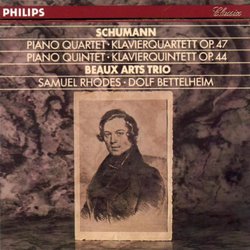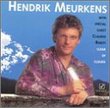| All Artists: Schumann, Rhodes, Beaux Arts Trio Title: Schumann: Piano Quartet in E flat/Piano Quintet in E flat Members Wishing: 0 Total Copies: 0 Label: Polygram Records Release Date: 10/25/1990 Genre: Classical Style: Chamber Music Number of Discs: 1 SwapaCD Credits: 1 UPC: 028942079120 |
Search - Schumann, Rhodes, Beaux Arts Trio :: Schumann: Piano Quartet in E flat/Piano Quintet in E flat
 | Schumann, Rhodes, Beaux Arts Trio Schumann: Piano Quartet in E flat/Piano Quintet in E flat Genre: Classical
|
Larger Image |
CD DetailsSimilar CDs
|
CD ReviewsGreat cd of Schumann's chamber music Amy | 08/05/2007 (5 out of 5 stars) "It was with the encouragement of his friend Felix Mendelssohn that Schumann turned his creative attention to chamber music. Until the end of 1840 his entire output, though altogether splendid in quality, had comprised only miniatures. These piano pieces and songs were profound and moving,but of course there was little development on the larger scale. During 1841 this mould was broken with the creation of several orchestral works, while the following year he wrote a substantial quantity of chamber music, a reflection of his preference for concentrating on particular types of composition at different periods of his life. The Piano Quintet and Piano Quartet are both products of this chamber music year in 1842. Of the Quintet Schumann said: `The music seemed to please players and listeners alike.' It is not hard to understand why. For example, the first movement is a magnificent example of the surging romanticism of which Schumann was a master. The players of the Schubert Ensemble capture this feeling through their excellent playing, and there great intensity. Throughout the piece they achieve a highly effective balance between lyrical flow and rhythmic tempo. In the second movement, entitled In modo d una marcia, the funereal tread of the accompanying rhythm has a very atmospheric quality about it. Into this context the consoling second theme is sensitively played, and this in turn enhances the effect made by contrast made by the wild and furious section within what is otherwise a serene movement. In the Scherzo the players skilfully point up Schumann's contrasted accents, while the two contrasting trios are effectively characterised. On the other hand the finale has a real sense of momentum. The Piano Quartet also benefits from the clear and sympathetic reading the musicians give. Like the Quintet, this work has an intensity of feeling that brings out Schumann's creative personality to the fullest. These features are encouraged by the good judgment of tempo and phrasing of the Schubert Ensemble. The second movement, a fast Scherzo, is a great challenge to the players ability to keep together and create an incisive rhythmic activity, and the challenge is met successfully. The slow movement has a beautiful flowing line, whereas the finale is taken at the sprightly Vivace tempo Schumann demands. The Schubert Ensemble is that rarity, a chamber music grouping of strings and piano who play regularly together, rather than just occasionally. And it shows.
" |

 Track Listings (8) - Disc #1
Track Listings (8) - Disc #1
